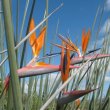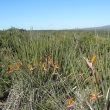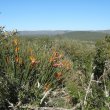| Botanical Name |
|
| Family |
Strelitziaceae - The strelitzia family. |
| Pronunciation |
stre-LITZ-ee-uh JUN-kee-uh |
| Common Name(s) |
|
| Plant Group |
- Bulb / Corm / Rhizome / Tuber / Epigeal bulb Bulbs: are made up of fleshy scales as in an onion
Corm: a short, swollen, underground stem that is hard and not fleshy as in a gladiolus
Tuber: a solid, fleshy, underground, storage organ as in a potato
Rhizome: an underground, horizontal, swollen stem at the base of the plant as in an iris
Epigeal bulb: bulbs that rest above the ground with only the roots anchoring the plant to the earth as in albuca
|
| Plant Size |
- Very large
| Tree | Over 25m |
| Shrub | Over 4m |
| Perennial/ground cover | Over 1m |
| Bulb | Over 1.2m |
| Succulent | 1.5m to 2m |
|
| Position |
- Canopy Shade Canopy shade is found below closely grown trees where some light filters through. Ideal for the protection of herbaceous plants.
- Dry Shade Shady areas where soil has poor water retention or are dependent on rain for their moisture needs.
- Light or Dappled Shade Found below trees with sparse, open foliage. Ideal for the protection of herbaceous plants.
- Partial Shade The area is in shade for part of the day and in full sun for part of the day.
- Sun The area is in full sun for all or most of the day, all year round.
|
| General Information |
- Drought Tolerance: High The plant is well adapted to arid conditions; it can survive long periods of drought and high temperatures without extra water.
- Evergreen Plants that have leaves all year round.
- Frost: Half-hardy The plant is able to survive low temperatures and some frost but requires protection against severe frost.
- Water Wise Plant species originating from low rainfall regions that require less water to survive and thrive than other plant species.
- Wind Tolerant Plants able to withstand the effect of strong winds.
|
| Specific Information |
Strelitzia juncea is a striking feature plant and much sought after. The leaves, lacking a leaf blade, are cylindrical, stiff and upright. The flowers are much the same as those of Strelitzia reginea, but are held below the level of the leaf tips, rather than above, as in the case of Strelitzia reginea. The plant is slow growing and takes four years to flower from seed, and two to three years to recover if divided. The flowers are pollinated by sunbirds and sugarbirds.
Strelitzia juncea is classed as vulnerable in its natural habitat due to quarrying and industrial development, illegal collection for the horticultural trade and invasive plants. The number of natural bird pollinators has also declined and the plants produce very little seed, further endangering their survival in the wild.
(Many thanks to Johan Snyman for the use of his photos)
|
| Ad Break |
|
| Flowers |
| Description |
striking boat-shaped head with long spiked petals, reminiscent of a crane's crest
|
| Season |
- Autumn to Winter Plants will seldom bloom for the entire season as given in the list, but should flower during a period within these parameters.
|
| Colour |
|
| Growth Rate |
- Very Slow Specifying growth rate can be very misleading as there is considerable variation of growth rate depending on type and species of plant, available water, supplementary feeding, mulching and general care, as well as the plants suitability and adaptability to the garden environment.
|
| Plant Uses |
- Accent or Focal Point A plant used to attract the attention because of its colour or form.
- Attracts bees, butterflies or other insects This plant attracts insects which can be food for birds or other creatures in your garden.
- Attracts Birds This plant will attract birds.
- Border A strip of ground, at the edge of a driveway or path in which ornamental plants or shrubs are planted.
- Boundary A plant useful for planting around the edges of the property to form a green or colourful backdrop, an impenetrable hedge, to hide walls or create privacy.
- Container Trees, shrubs and ornamental species that can adapt to growing in a restricted environment.
- Cut Flowers Plants that provide flowers suitable for ornamental uses.
- Filler Either a fast growing tree or shrub used temporarily to fill in an area while the permanent plants grow to a desired size, or a plant used to fill gaps in borders or beds.
- Mass Planting Plants useful for filling a large area with just one or a few kinds of plants spaced close together. Creates a bold, dramatic effect and to reduces maintenance.
- Rock Garden An area constructed of larger rocks, arranged naturally, to emphasise the use of stones as a main element. Generally plants used do not need a lot of care.
- Suitable for coastal gardens Plants adapted to dry, sandy soil, forceful wind, limited rainfall and intense sunlight.
- Water Features These plants may have dramatic, lush foliage or graceful form. They do not shed excessive leaves and do not have invasive root systems.
- Wild Garden An indigenous garden planted for the benefit of wildlife and birds. Provides food, water, a variety of mini-biomes and no poisonous chemicals are used.
|
| Distribution and Habitat |
in the Eastern Cape in only six locations, in an area north of Port Elizabeth to Uitenhage and Patensie, in Succulent Albany Thicket , often on harsh, rocky outcrops
|
| Planting Suggestions |
To ensure faster growth and improved flowering, plant in well drained soil with a mixture that has 1 part superphosphates, 2 parts 3.1.5, and 1 part bone meal added to the planting hole. The same mixture can be scattered around the plant annually in mid-summer. A thick dressing of compost and mulch should be laid around the plants in winter. Divide clumps in autumn or winter. The fleshy, deep roots break easily and great care must be taken during digging to prevent root damage. Large clumps of half a meter diameter will ensure that plants will recover faster. If smaller clumps are desired the plants will take longer to recover.
Strelitzia juncea can be grown in a large container in a potting mix of 2 parts loam, 2 parts sand, 3 parts bark, 3 parts compost, ½ part of bone meal and 1 part Bounce Back (slow release organic fertiliser).
|
| Medicinal Uses |
|
| Ad Break |
|








Discuss this plant
Share knowledge, ask a question or give an experience.